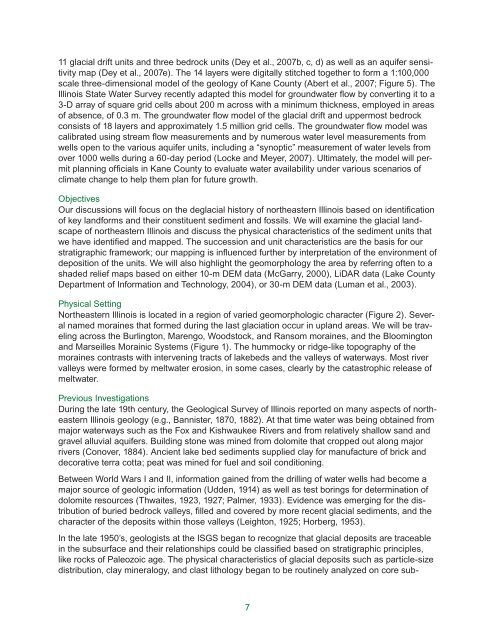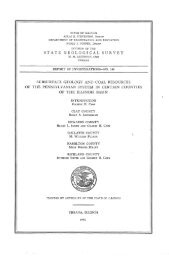Deglacial History and Paleoenvironments of Northeastern Illinois
Deglacial History and Paleoenvironments of Northeastern Illinois
Deglacial History and Paleoenvironments of Northeastern Illinois
- No tags were found...
You also want an ePaper? Increase the reach of your titles
YUMPU automatically turns print PDFs into web optimized ePapers that Google loves.
11 glacial drift units <strong>and</strong> three bedrock units (Dey et al., 2007b, c, d) as well as an aquifer sensitivitymap (Dey et al., 2007e). The 14 layers were digitally stitched together to form a 1:100,000scale three-dimensional model <strong>of</strong> the geology <strong>of</strong> Kane County (Abert et al., 2007; Figure 5). The<strong>Illinois</strong> State Water Survey recently adapted this model for groundwater flow by converting it to a3-D array <strong>of</strong> square grid cells about 200 m across with a minimum thickness, employed in areas<strong>of</strong> absence, <strong>of</strong> 0.3 m. The groundwater flow model <strong>of</strong> the glacial drift <strong>and</strong> uppermost bedrockconsists <strong>of</strong> 18 layers <strong>and</strong> approximately 1.5 million grid cells. The groundwater flow model wascalibrated using stream flow measurements <strong>and</strong> by numerous water level measurements fromwells open to the various aquifer units, including a “synoptic” measurement <strong>of</strong> water levels fromover 1000 wells during a 60-day period (Locke <strong>and</strong> Meyer, 2007). Ultimately, the model will permitplanning <strong>of</strong>ficials in Kane County to evaluate water availability under various scenarios <strong>of</strong>climate change to help them plan for future growth.ObjectivesOur discussions will focus on the deglacial history <strong>of</strong> northeastern <strong>Illinois</strong> based on identification<strong>of</strong> key l<strong>and</strong>forms <strong>and</strong> their constituent sediment <strong>and</strong> fossils. We will examine the glacial l<strong>and</strong>scape<strong>of</strong> northeastern <strong>Illinois</strong> <strong>and</strong> discuss the physical characteristics <strong>of</strong> the sediment units thatwe have identified <strong>and</strong> mapped. The succession <strong>and</strong> unit characteristics are the basis for ourstratigraphic framework; our mapping is influenced further by interpretation <strong>of</strong> the environment <strong>of</strong>deposition <strong>of</strong> the units. We will also highlight the geomorphology the area by referring <strong>of</strong>ten to ashaded relief maps based on either 10-m DEM data (McGarry, 2000), LiDAR data (Lake CountyDepartment <strong>of</strong> Information <strong>and</strong> Technology, 2004), or 30-m DEM data (Luman et al., 2003).Physical Setting<strong>Northeastern</strong> <strong>Illinois</strong> is located in a region <strong>of</strong> varied geomorphologic character (Figure 2). Severalnamed moraines that formed during the last glaciation occur in upl<strong>and</strong> areas. We will be travelingacross the Burlington, Marengo, Woodstock, <strong>and</strong> Ransom moraines, <strong>and</strong> the Bloomington<strong>and</strong> Marseilles Morainic Systems (Figure 1). The hummocky or ridge-like topography <strong>of</strong> themoraines contrasts with intervening tracts <strong>of</strong> lakebeds <strong>and</strong> the valleys <strong>of</strong> waterways. Most rivervalleys were formed by meltwater erosion, in some cases, clearly by the catastrophic release <strong>of</strong>meltwater.Previous InvestigationsDuring the late 19th century, the Geological Survey <strong>of</strong> <strong>Illinois</strong> reported on many aspects <strong>of</strong> northeastern<strong>Illinois</strong> geology (e.g., Bannister, 1870, 1882). At that time water was being obtained frommajor waterways such as the Fox <strong>and</strong> Kishwaukee Rivers <strong>and</strong> from relatively shallow s<strong>and</strong> <strong>and</strong>gravel alluvial aquifers. Building stone was mined from dolomite that cropped out along majorrivers (Conover, 1884). Ancient lake bed sediments supplied clay for manufacture <strong>of</strong> brick <strong>and</strong>decorative terra cotta; peat was mined for fuel <strong>and</strong> soil conditioning.Between World Wars I <strong>and</strong> II, information gained from the drilling <strong>of</strong> water wells had become amajor source <strong>of</strong> geologic information (Udden, 1914) as well as test borings for determination <strong>of</strong>dolomite resources (Thwaites, 1923, 1927; Palmer, 1933). Evidence was emerging for the distribution<strong>of</strong> buried bedrock valleys, filled <strong>and</strong> covered by more recent glacial sediments, <strong>and</strong> thecharacter <strong>of</strong> the deposits within those valleys (Leighton, 1925; Horberg, 1953).In the late 1950’s, geologists at the ISGS began to recognize that glacial deposits are traceablein the subsurface <strong>and</strong> their relationships could be classified based on stratigraphic principles,like rocks <strong>of</strong> Paleozoic age. The physical characteristics <strong>of</strong> glacial deposits such as particle-sizedistribution, clay mineralogy, <strong>and</strong> clast lithology began to be routinely analyzed on core sub-7
















